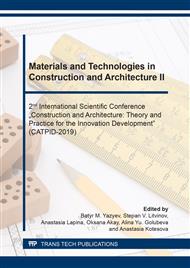p.336
p.342
p.350
p.356
p.362
p.367
p.373
p.379
p.386
Aerated Concrete Based on Cullet and Liquid Glass
Abstract:
The possibility of using technical glasswork with liquid glass to produce aerated concrete using low-energy technology was considered in the paper. The unsorted technical glass cullet use as a part of aerated concrete will allow the non-decomposing industrial wastes disposal, which makes it possible to speak about the environmental technology development, while reducing the cost of producing effective heat-insulating materials considers its economic efficiency. The optimum liquid glass density was established upon aerated concrete mix receipt, which should be at least 1.23 and not more than 1.35 g / cm3. The technical characteristics of aerated concrete based on cullet and liquid glass obtained in this work are determined. Thermal conductivity of aerated concrete with its density of 150-400 kg / m3 is 0.06 W/m°C. The resulting aerated concrete is recommended for thermal insulation of pipelines both during construction and during their repair.
Info:
Periodical:
Pages:
362-366
Citation:
Online since:
December 2019
Price:
Сopyright:
© 2020 Trans Tech Publications Ltd. All Rights Reserved
Share:
Citation:


